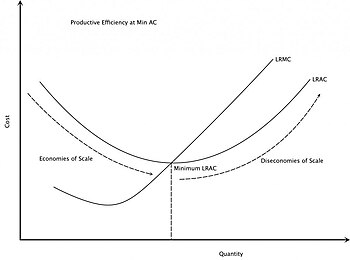
Back تبذيرات الحجم Arabic Дисикономии на мащаба Bulgarian Deseconomía de escala Spanish Déséconomie d'échelle French חיסרון לגודל HE Diseconomie di scala Italian 규모의 비경제 Korean Diseconomies of scale SIMPLE Stordriftsnackdel Swedish 規模不經濟 Chinese
This article needs additional citations for verification. (July 2016) |

In microeconomics, diseconomies of scale are the cost disadvantages that economic actors accrue due to an increase in organizational size or in output, resulting in production of goods and services at increased per-unit costs. The concept of diseconomies of scale is the opposite of economies of scale. It occurs when economies of scale become dysfunctional for a firm.[1] In business, diseconomies of scale[2] are the features that lead to an increase in average costs as a business grows beyond a certain size.
- ^ "Diseconomies of Scale Definition: Causes and Types Explained". Investopedia. Retrieved 2024-04-12.
- ^ Chappelow, Jim. "Understanding Diseconomies of Scale". Investopedia. Retrieved 2020-05-16.